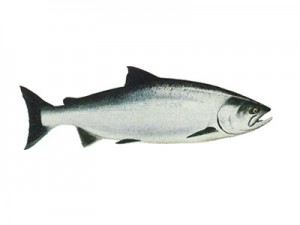Prior to the 19th century, the Great Lakes supported incredible numbers of wild Atlantic salmon. Overfishing, disease, parasitic lampreys, habitat loss, and other factors decimated the species. Present day Atlantic salmon restoration projects continue in the Great Lakes, although success has been limited.
Three species of non-native Pacific salmon are found in the Great Lakes. Chinook and coho salmon have been stocked in lakes Michigan, Huron, Ontario, Erie and Superior. Pink salmon are found throughout the Great Lakes.
Chinook salmon have been stocked in the Great Lakes for over a century. The species has failed to find suitable spawning habitat, so continuous stocking is necessary to maintain Chinook populations. Adult Chinook salmon in the Great Lakes feed heavily on alewives.
Coho, or silver salmon have been stocked in lakes Michigan and Superior since 1966 and are considered to be an essential component of the Great Lakes “put-and-take” sport fishing industry.
Mature coho salmon prey on alewives, smelt, and other forage fish. In Lake Michigan, cohos attain an average weight of five to six pounds, occasionally reaching weights of 10 pounds or more. In Lake Superior individuals are typically smaller in size due to less abundant food supplies.
Coho salmon spawn successfully in Lake Superior tributaries and have developed self-sustaining populations in the waterway. They reproduce naturally in parts of Lake Michigan, but their general population must be sustained with hatchery-reared fish.
In 1956, about 21,000 pink salmon were introduced to a tributary of Lake Superior. Although the species took decades to establish itself, self sustaining populations of pink salmon are now found in all of the Great Lakes. Pink salmon are caught using trolled rigs and have become a sport fish in the region.
Related Information
